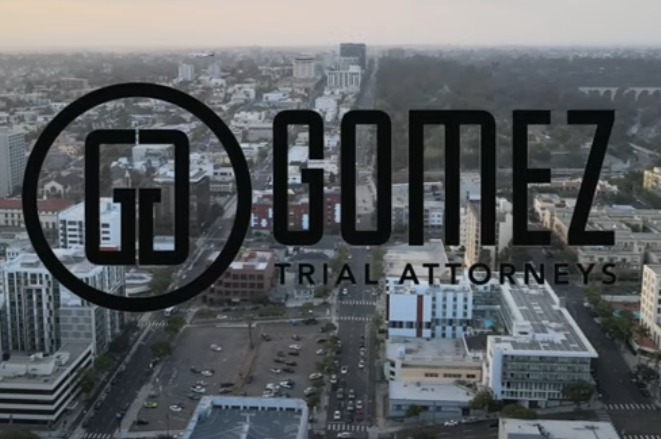Table of Contents
A brain stem injury is when trauma, disease, or other factors impact the function of the region of the brain known as the brain stem. Since the brain stem is essential to life, these sorts of injuries often prove very serious, if not deadly. For more brain injury legal information, contact an experienced California brain injury attorney at Gomez Trial Attorneys near you.
What Types of Traumatic Events Cause Brain Stem Injuries?
Brain stem injuries are some of the most devastating, impacting essential bodily functions and leading to long-term or even life-threatening conditions. They can occur due to numerous causes, and some of the most common ones include:
Car Accidents
High-speed collisions, as well as vehicles flipping and rolling over due to accidents, can easily cause severe whiplash or a direct blow to your head, leading to brain stem injuries. The brain stem controls critical bodily functions; thus, any damage there could be particularly devastating.
Sports Injuries
In contact sports like football, hockey, or boxing where hard hits are common — or activities with fall risks like horseback riding — participants may experience powerful impacts that subsequently result in brain stem injuries.
Falls
Tripping down stairs or falling from significant heights (such as ladders or roofs) often results in severe head injuries affecting the brainstem. These injuries also commonly occur among children and older adults who have an increased risk of falls at home.
Violence
Acts of violence such as assaults or gunshot wounds to the head can directly damage the brain stem. Child abuse can also result in devastating brain stem injuries.
Drowning
When oxygen levels drop significantly due to near-drowning experiences — where a person survives but is severely hypoxic — it could potentially cause irreversible harm reaching your brainstem and leading to substantial disability or even death.
Hit by Objects
Getting hit on the head with a flying or falling object can also lead to brain stem injuries. This is frequently seen in construction workers who sustain accidents involving dropped tools or debris at sites, but it can occur in a variety of situations.
Immediate medical attention and diagnosis are essential following any incident causing potential harm to your head or brain.
What Are Some Effects of a Brain Stem Injury?
Brain stem injuries often lead to dire consequences given the brainstem’s role in regulating many basic bodily functions. Some potential effects can include:
Paralysis
A brain stem injury may lead to paralysis, rendering you unable to move certain parts of your body. Depending on the extent and location of damage in your brainstem, this could range from difficulty moving facial muscles or an arm to quadriplegia which is complete paralysis from the neck down.
Death
Severe injuries could have deadly outcomes since vital functions such as heart rate and respiration are managed by the brain stem.
Coma
A severe brain stem injury might lead to a coma, a prolonged state of unconsciousness in which you can’t be awakened and fail to respond to stimuli.
Memory Loss
In some cases, it could affect information processing capacities such as recall and cognition, leading to memory loss.
Loss of Motor Function
Balance and movement coordination could also be affected after brain stem injuries as motor pathways running through the midbrain down to your limbs are sometimes disrupted.
Difficulty Breathing
The brainstem controls our breath while we’re conscious and unconscious. Damage to this area may pose serious challenges for respiration potentially requiring you to need assistance through ventilators.
Disruption of Involuntary Bodily Functions
Bodily functions a person does not consciously control, such as heart rate, digestion, or temperature management may be significantly disrupted when the brain stem is damaged.
Problems With Speech
Patients with injured brain stems often exhibit difficulties with speech. The specific impairments depend on the areas of the brainstem that are affected.
Brain Death
In the most extreme cases, a severe brain stem injury could result in brain death. Here, all normal activity in the brain halts even as the heartbeat and respiration may continue with support from machines. Brain-dead individuals cannot regain consciousness or host any chances of recovery.
Given the essential role of the brain stem in sustaining basic bodily functions, injuries to this area can drastically impact an individual’s life quality or even prove fatal. That’s why it is so critical to prioritize safety and seek immediate medical attention if trauma occurs.
Why You Need an Attorney To Help With Your Brain Stem Case
Brain stem injury cases can be complex and emotionally draining. Having an attorney by your side provides important advantages:
Legal Expertise
Brain stem injuries involve intricate medical understanding and substantial damages due to their potential for severe effects on life quality. An attorney skilled in this area will understand the complexities involved, helping you prepare a solid case to get you the justice and compensation you’re entitled to.
Objective Judgment
After suffering such a traumatic event, it’s challenging to navigate legal procedures objectively on your own – understandably, personal emotions could cloud judgment at times. Attorneys offer objective viewpoints making sure all decisions move towards serving your best interests.
Collecting and Preserving Evidence
In order to build a strong case, you need substantial evidence. This includes everything from medical records to photos of injuries or possibly expert witness testimonies. An attorney knows exactly what information is necessary, how to acquire it, and how to present it most effectively in your case.
Negotiation Skills
In most cases, personal injury claims are resolved before they go to trial through a settlement with the insurance company. Attorneys are experienced in negotiating appropriate settlements to ensure you don’t get shortchanged.
Overall, partnering with an attorney can significantly reduce your burden and increase the probability of achieving a favorable outcome in your case.
Recoverable Compensation After a Brain Stem Injury
If your brain stem injury resulted from someone else’s negligence, you might be entitled to compensation across three distinct categories:
Economic Damages
This type of compensation is designed to help cover out-of-pocket costs that can be objectively quantified into monetary terms, such as medical expenses, cost of rehabilitation, therapy, and lost wages if the injury led you to miss work or reduced your ability to earn a living. It can also include future costs incurred due to ongoing care and maintenance.
Non-Economic Damages
Sometimes the impacts of an unfortunate injury go beyond economic hardships and include more intangible losses. As such, non-economic damages compensate for abstract losses like physical and emotional pain and suffering that emerge from trauma, loss of enjoyment of life, or loss of consortium.
Punitive Damages
Punitive damages are awarded not as a means of compensation for injury, but rather to penalize the negligent party and serve as a deterrent for others. However, punitive damages are relatively rare in personal injury cases — they’re typically only granted if it’s proven that the individual’s conduct was extremely irresponsible or intentional.
Navigating these elements efficiently requires professional legal guidance from an attorney who specializes in medical malpractice cases.
Contact Gomez Trial Attorneys for Help With Your Brain Stem Injury Claim
Dealing with a brain stem injury can be life-altering. While you focus on your recovery, leave the legal burden to experts like Gomez Trial Attorneys who are experienced in navigating such complex cases. We’ll work tirelessly to ensure you get the compensation and justice you deserve. For help with your claim, contact us today for a free consultation by calling 619-237-3490 or by contacting us online.
FAQs
What happens if the hindbrain is damaged?
The hindbrain is an essential part of our central nervous system. Located at the back portion of the brain, the hindbrain contains structures such as the medulla oblongata, the pons, and the cerebellum. These play crucial roles in coordinating functions vital to life, such as maintaining balance, monitoring heart rate, and regulating breath.
The hindbrain acts like a superhighway for messages traveling between the brain and the spinal cord. These messages are essentially commands: when the brain wants to move your arm, for example, it sends the order down this ‘highway’ and delivers it to the necessary muscles.
Damage to the hindbrain can lead to significant consequences given its responsibility for numerous crucial functions. Depending on the extent and location of damage within the hindbrain, it could disrupt these critical biological processes leading to issues with movement control or even life-threatening complications.
A skilled personal injury attorney can help understand the implications of your injury and guide you through the process of seeking compensation.
What happens if the medulla is damaged?
The medulla oblongata is a part of the brain called the hindbrain, situated at its lowest point. Its location plays a crucial role in acting as the connection bridge between your brain and spinal cord, facilitating neuropathways to relay signals back and forth.
When the medulla oblongata is damaged, consequences can be wide-ranging and potentially very serious. Given its role in regulating vital functions such as heart rate, blood pressure, and breathing — along with reflex actions like coughing or vomiting — any impairment could lead to life-altering changes in bodily functions, like respiratory failure, paralysis, or loss of sensation.
If a person sustains an injury that possibly implicates damage to the medulla oblongata, it’s of absolute importance that medical attention be sought urgently.
What happens if the pons is damaged?
Damage to the pons can lead to disturbed sleep/wake cycles, or difficulty in movements, particularly those involving the face. Even more concerning, severe damage could result in a state known as ‘locked-in syndrome’, where an individual becomes almost entirely paralyzed and is unable to speak or move despite being completely conscious.
In even more extreme cases, significant trauma may even lead to life-threatening conditions. Therefore, any suspicion of injury impacting the pons should be treated with urgency.
Can the brain stem repair itself?
An injury to the brain stem can be extremely grave and can drastically alter a person’s life. This area of our nervous system controls many essential bodily functions, so any damage may lead to serious health consequences.
Treatment options and chances of recovery depend heavily on how severe the brain stem injury is. Typically, only about 25% of patients will make a full recovery after treatment. Tragically, 30% do not survive the trauma. The rest—almost half—are left grappling with disabilities which significantly negatively impact their quality of life.
Further complicating matters is that brain stem injuries are resistant to self-repair—even with intensive therapeutic intervention—the healing process could remain incredibly tough.
Remember though, that these figures are general statistics and your specific situation may be different. Each injury case differs based on an array of factors and so does each patient in terms of health status.







